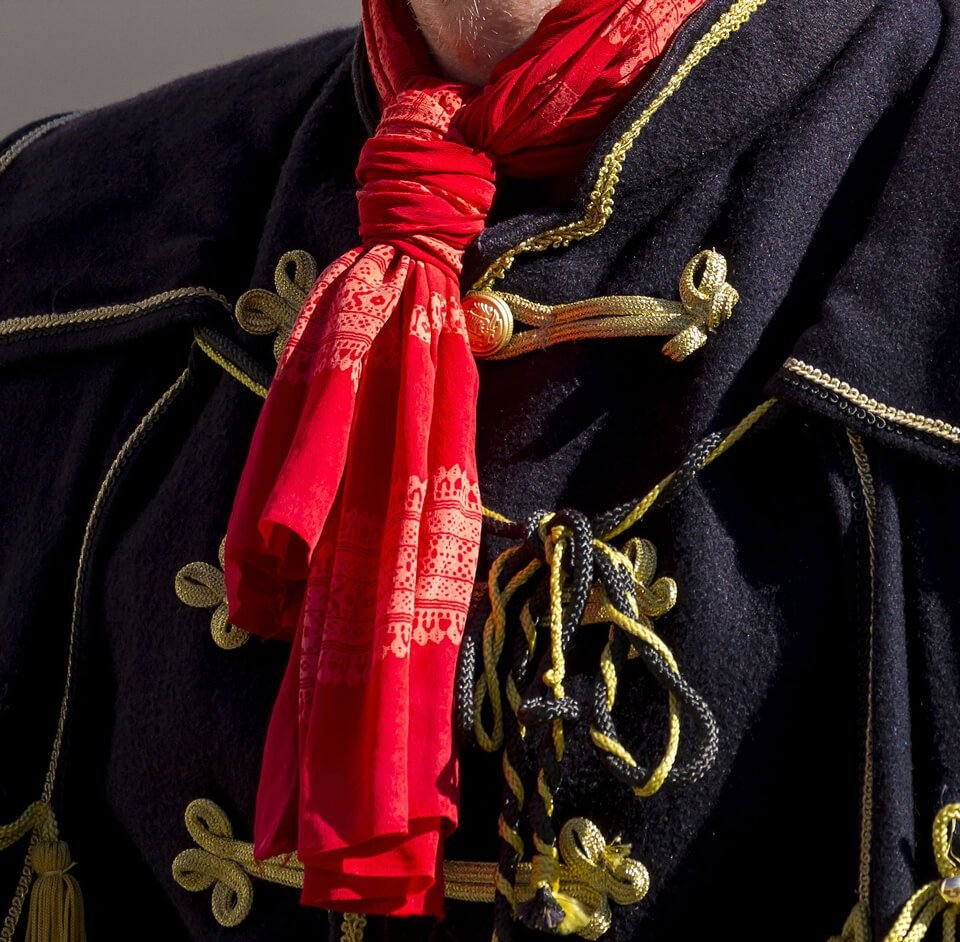Military get-up may have been designed with practicality and uniformity in mind, but there’s no doubt the military influenced the world of fashion. From camouflage to cargo pants, from runways to thrift stores, military-inspired fashion has become a cornerstone of our wardrobes.
Full of ceremonial swagger and timeless style, we salute the lesser known gems of military-inspired fashion in this post.
Table of Contents
1. Croatian Mercenaries and Birth of the Necktie
The French will probably dispute this, but history shows that during the 30 years war (1618-1648) Croatian mercenaries rocked up to battle with bright scarves wound tightly around their necks. So tightly, in fact, that many fainted as a result. The French, always with a keen sartorial sense, adopted the look and chose to loop the scarves in a looser, more comfortable way. And presto, the birth of “la croate” — more commonly known as “la cravat” — hit everyday fashion. Today, cravats and it’s younger brother the “tie” are a staple in dapper gents wardrobe, yet many are unaware of their sartorial beginnings on the battlefield.
2. British Colonial Soldiers and Earthy Khakis
British soldiers used to deck themselves out in bright red coats — hence the name “Redcoats”. But when war was waged in the Punjab, the tight scarlet tunic wasn’t the ticket. Instead, commanding Officer Harry Lumsden gave his men coarse cotton smocks dyed with a local plant that turned everything an earthy grey-brown. This new military styling became known as khaki, coming from the Persian word “khak” for earth or dust. Today, khaki is everywhere, from chinos to jackets, dresses to gym clothes — and it all began with some sweaty British soldiers in the jungle!
3. Dutch Naval Forces and the Pea Coat
Derived from the Dutch word “pije”, which describes a coarse twilled blue cloth, the pea coat as we know it burst into the fashion scene in sixteenth century as the favoured coat of the Dutch naval forces. Aside from its pleasing aesthetic, the pea coat was favoured for the durability and warmth of its double-breasted design. Add in some large lapels and vertical pockets and you’ve got yourself a fashion stalwart. Since then, pea coats have never gone out of fashion — thanks in no small part to Yves Saint Laurent’s 1960 military-inspired pea coat collection.
4. The First World War and Trench Coats
No one item pays homage to British heritage quite like the trench coat. It’s history goes back to 1853 when none other than Burberry designed practical (and stylish) coats for the men fighting in the Crimean War. Made from a patented waterproof wool and with distinctive large lapels, epaulets and a convertible collar — it hit that sartorial sweet spot between style and practicality. Of course, the trench coat really came into its own during the First World War where the trench coat as we know it came into being. Check your trench coat today and you’ll see the evidence of trench practicality — a handy belt for holding maps, a gun flap for, well, the gun, and the distinctive storm shield that allows water to wash off your back. We bet you didn’t know you were wearing a little slice of military history every time you donned your trench coat.
5. Flying High with Ray-Ban Aviators
How do you solve the problem of sun-glare when flying at new heights in the 1930s? Simple answer, you invent timeless sunglasses. The aviator sunglasses may seem like they were handmade for high-fashion, but they were originally conceived as a way to tackle headaches and altitude sickness induced by the sun. Plastic and then later metal frames, with classic aviator shape, the Ray-Ban aviators have become an absolute style sensation. From Tom Cruise’s Maverick to Clint Eastwood cool, eyewear has never been so downright chic. Practical and stylish — exactly what we’ve come to expect of military fashion.
6. New Heights of Fashion with Airman Bomber Jackets
We have the United States aviators of the First World War to thank for this one. Back then, airmen were exposed to the chilly climbs and high-speed winds when flying so they needed a jacket that could keep them warm without inhibiting their movements. The result? Sealskin leather flight jackets with cotton lining, zipper closures, wind flaps, wraparound collars, snug fitting cuffs and waist. Today, the sealskin may be out-of-trend, but Bomber jackets show no sign of ever going out of fashion.
7. Dr. Martens Solution to WWII Injuries
These heavy-duty boots may now be synonymous with the counterculture — hardcore punk and hipsters alike — but these sturdy stompers were actually designed by German doctor, Klaus Martens, during World War II after he sustained a nasty ankle injury in the Bavarian Alps. The shoes he invented had an air-conditioned sole, sturdy build and without a doubt changed the face of footwear for years to come.
